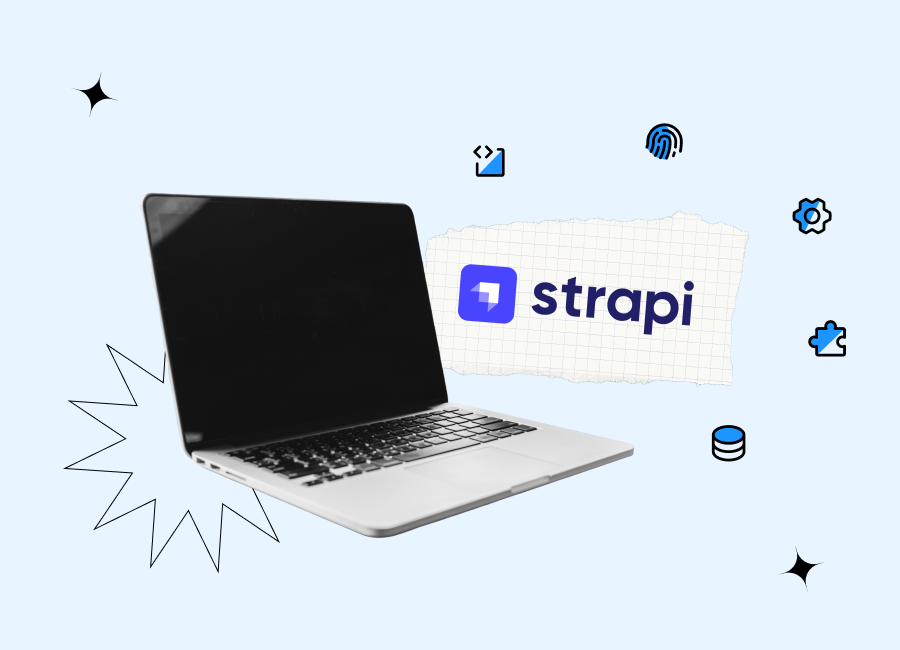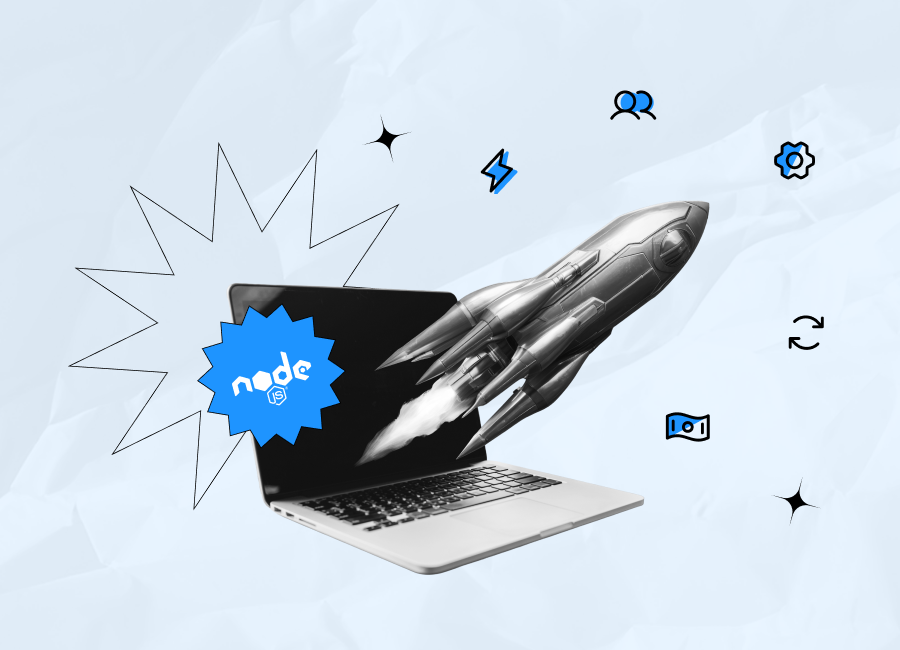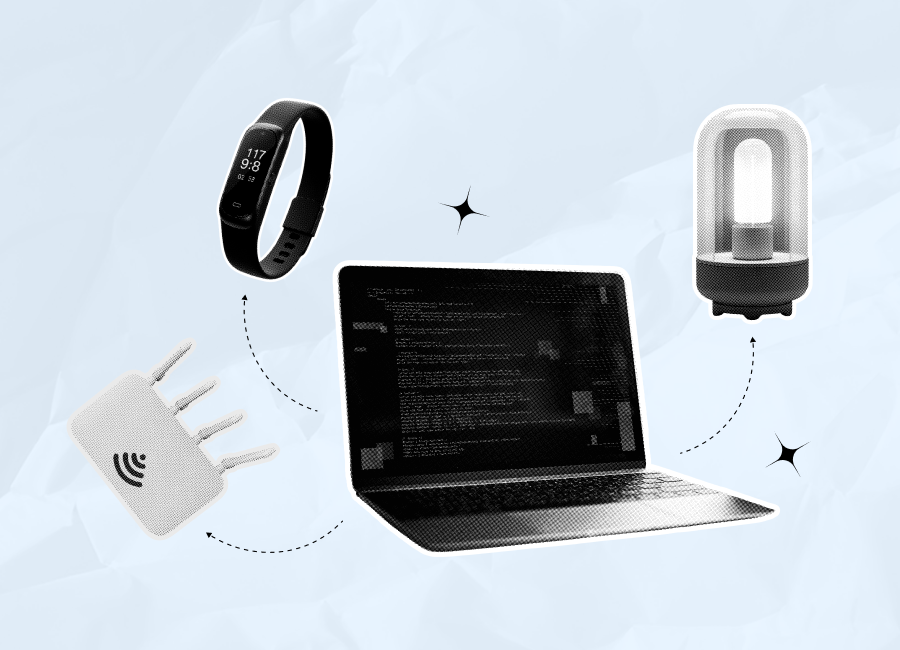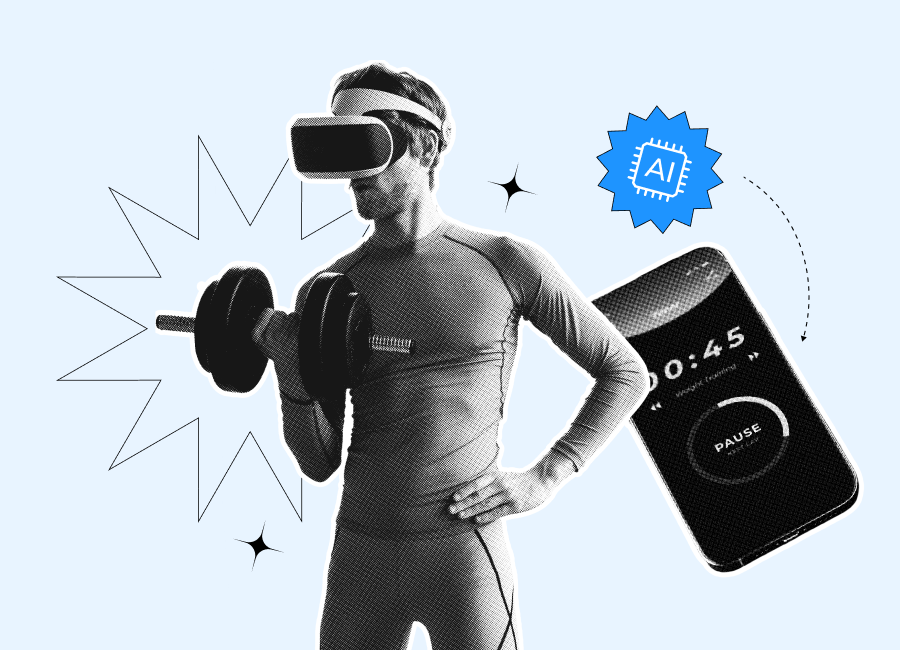In this article, we’ll guide you through everything you need to know about how to develop IoT applications. We’ve gathered opinions, recommendations, and real cases from our IoT experts and are ready to share our rich experience of harnessing the power of IoT and making it work at its highest capacity. Keep reading!
IoT Market Overview
We’ve already talked about how IoT systems are becoming increasingly essential to everyday life. From smart cities to our smartphones, smart homes, and smart cars, the market for the Internet of Things is getting more and more enormous by the year.

According to the January 2023 edition of Global IoT Corporate Spending Dashboard, the business IoT market expanded by 21.5% to $201 billion in 2022. IoT Analytics currently projects that between 2022 and 2027, the IoT market will increase at a CAGR of 19.4%, reaching $483 billion.
Major IoT Components
Most properly functional IoT networks should consist of the following four components (in the order of their involvement):

IoT Hardware
Sensors and other devices first gather information about their surroundings. This information may be as straightforward as a temperature report or as intricate as a whole video feed.
The hardware component of an IoT system can’t really be simplified to “sensors”, because several sensors can be combined or because sensors can be a component of a device that does more than just sense things. For instance, while having numerous sensors (such as a camera, accelerometer, GPS, etc.), a smartphone is more than just a sensor because it is capable of carrying out a variety of tasks.
Regardless, IoT hardware that is gathering data from the environment is component one.
IoT Connection Protocols
Once data is gathered, it needs to be transferred to a cloud where it’s going to be stored.
Below are some of the ways that the hardware can be transferring this data:
- WiFi
- Bluetooth
- LoRaWan
- Cellular
- MQTT
- XMPP
- Zigbee
- Z-Wave
There are compromises between each option's bandwidth, range, and power usage. The ideal connectivity method depends on the IoT application in question, but they all achieve the same goal: sending data to the servers.
IoT Data Server
The server stores and processes the data received from the hardware device. For servers, cloud services are the most commonly used option as they offer a great deal of security and low maintenance cost.
The IoT platform data can be of varying character. It may be making sure the temperature reading falls within the allowed range, or it may be identifying items (such as burglars on a property) using computer vision on video.
When certain data becomes actionable, such as the temperature getting too high or someone breaking into the property, the software application comes into play.
IoT Software
Lastly, we create IoT applications, or software, to visualize processed information and assist the user in taking action. The software can take many forms: it could be a mobile app, a web app web, or even so-called IoT middleware.
The software’s functionality varies from case to case, but most IoT apps have data visualization, remote control, and notification capabilities, among other things (more on that in the next section).
The user may have access to an interface that enables them to routinely monitor the IoT system. For example, a user might want to utilize a phone app or a web browser to check the video feeds on several properties.
The user might also be able to take action and influence the system, depending on the IoT platform. By using an app on their phone, the user might, for example, remotely change the temperature in the cold storage.
Users can also be sent notifications (by email, text, etc.) - for instance, a text message alarm when the cold storage facility's temperature rises too high.
Features Of IoT Applications
It’s only natural that different IoT applications will vary in functionality. However, there are a number of features that are essential for most of them:

Connectivity
The most basic feature for when we create an IoT app - without it being able to connect to hardware, it’s absolutely useless. With the help of one or multiple connection protocols, the software links with the IoT hardware so it can fulfill its other features.
Remote Control
Most IoT apps should support the functionality of controlling the hardware it’s connected to. This may involve changing the temperature, choosing a certain operational program or simply switching the device on and off.
Access Restriction
IoT networks store huge amounts of sensitive and personal data. That’s why access control through FaceID or PIN-code app locks, and secure data transmission methods are necessary for pretty much any IoT app.
GPS Tracking
A lot of IoT systems place a lot of importance on knowing the exact location of this or that device. Thus, including GPS tracking capabilities in the IoT app is pretty much a must.
User Profile
Personalization is of key importance when you create IoT applications. In the profile section, users will be able to control personal data, notification preferences, presence sensing, security, and privacy settings.
Data Analytics
IoT is all about valuable real-time insights and data. Depending on the nature of your IoT platform, the dashboard performs the crucial task of visualizing all that data, along with occasional reporting and analytics. This data could be anything, from the number of available parking spaces to room temperature.
Activity History
You may want to develop an IoT app with activity history included. It reveals which devices were activated or deactivated, how they were moved, and what activities were performed within the app.
Notifications
Users may stay informed and receive real-time updates on any changes thanks to notifications. For instance, when there is activity near the door, smart doorbells with motion sensors alert the user's device.
How-To-Use Tutorial
Tutorials in the form of screens that walk users through the interface and key features of the app help with onboarding and deliver a satisfying user experience.
A powerful IoT app - for your business?
Brilliant idea! Our IoT experts will take your company's tech stack to a new level!
Step-By-Step IoT App Development
The following section describes how to create IoT applications, as recommended and employed by Cogniteq:

Stage 0. Preparation Stage
This is the stage where the client comes up with the concept of an IoT application and compiles the first draft of its wanted features. The draft doesn’t need to be very specific - a high-level functionality description will suffice, and the rest will be handled by professional business analysts later on.
It’s also recommended, albeit not compulsory, that the client has already chosen the specific hardware (device/sensor) that they want to connect with the application. Along with that, it’s always good to have the protocol specs ready too. This means understanding how the hardware and the software are going to connect, be it WiFi, Bluetooth or any other protocol.
However, it’s completely OK not to have everything prepared - the team of professionals that build IoT applications regularly will fill in all the gaps with the client’s help. The only possible downside to that is that it makes the following stage longer and more intense.
Stage 1. Discovery Stage
This stage is when the client and the development team hold a series of workshops so that all the requirements for the team to develop an IoT app and the IoT network are clearly defined. The main deliverable coming out of the discovery stage is a detailed technical specification.
The spec includes the app’s architecture, design, and connection protocol description. By that time, the type of hardware is also established. The team also provides a quote and a project timeline - while these are tentative and may change during the development, they’re not expected to alter massively.
Stage 2. Agile Development & Testing Stage
This is the stage where the team starts to build IoT applications. We don’t highlight app testing as a separate stage due to the agile nature of our development processes. IoT app development and testing it against the selected IoT devices are taking place in short iterations (sprints) so that any possible errors are eliminated in a timely manner.
Stage 3. Client Acceptance Stage
This is the stage when the approved scope of work is completed and the client receives a fully functional IoT application. The client deploys it, receives initial user feedback and if deemed necessary, some further tweaks are made.
Alternatively, if the first version of the IoT app was always meant to be just a proof of concept, then further development is also going to take place, enriching the app with more features.
Stage 4. Further Development Stage
The team continues to work on the app as long as the client deems it reasonable. The scope of further development could be of any size - from incremental changes to massive architecture overhauls. The end goal is always to build IoT applications of the highest quality possible within the provided budget and timeframe.
How Much Does it Cost To Make an IoT App in 2023?
It goes without saying that the development cost of an IoT app will hugely depend on its functionality.
From our IoT app development experience, an initial proof of concept can realistically be delivered starting from $10,000. These are the cases where the app has a rather simplistic design, only a few screens and the connection protocol development is powered by an already made solution.
If the client wishes to build a fully-fledged, feature-rich IoT app, they should expect the cost to start at around $50,000. For that price, the team will be able to perform very complicated and time-consuming operations, such as enabling multiple connection protocols.
Either way, creating an IoT app is a serious investment that takes a lot of attention and consideration. We strongly advise against contacting development teams of questionable competence in an attempt to save as much as possible. However, we can share a couple of tips that can help reduce the costs of IoT app development without hampering its quality.
How to Cut Costs on IoT App Development
The main determinant of any costs for IoT app development is the amount of time spent on it. Thus, everything that saves time for the dev team will result in reduced costs for the client.
The following cost-cutting opportunities have been highlighted by our IoT experts:

Ready-Made Solutions
One of the most common ways of saving money is integrating ready-made solutions into the IoT application. One of the solutions our team has used a number of times is called Flespi. For example, we implemented it when working on an IoT app for monitoring the locations of GPS trackers. In that case, Flespi served as a back-end for registering the GPS trackers in the system, which saved the team a lot of time - otherwise, we’d have to code the back-end ourselves.
Existing Cloud Services
There also exist many powerful cloud solutions for both Android and iOS. Tech giants like Google, Amazon, Microsoft, IBM, and Oracle all offer their cloud services to help build IoT apps. That’s why when looking for a development team for your app, the client should ask about the team’s experience of working with the above solutions. If a team has this know-how, it can save the client a lot of money.
Pre-Installed Connection Protocols
When you develop an IoT app, It helps to have connection protocols and SDKs pre-installed on the selected IoT hardware. This eliminates the need for the team to create an SDK themselves, so the client must choose the hardware smartly.
One Connection Protocol
Moreover, using only one connection protocol instead of multiple can reduce dev costs significantly. The downside to that if, for instance, the Internet connection is faulty, the app won’t be able to connect through Bluetooth, as it’s relying on WiFi only.
Simple User Interface
We also recommend employing simplistic UIs when you make an IoT app, as the app’s biggest strength and value is in its data-related functionality, not slick looks. The less time a team spends on creating the visuals, the better.
One Platform
Finally, we usually advise against cross-platform IoT solutions. Cross-platform apps are associated with saving money, however, it doesn’t work the same way with IoT due to the specifics of the technology. Your best shot at the cheapest IoT app would be to settle for a native proof of concept for just one platform (Android or iOS). If the app is a success, you can later invest more funds and create a second native app for the other platform.
Cogniteq IoT Development Expertise
Our team has leveraged the power of IoT technology on many occasions. For instance, we developed IKAWA, an IoT-powered remote control app for a coffee roaster brand.

IKAWA asked the Cogniteq team to create two different mobile apps for iOS and Android platforms from scratch (4 apps in total) and provided us with their designs of app screens. The idea was to create separate apps for two different coffee roaster versions (IKAWA Home and IKAWA Pro).
To save money and avoid developing similar functionality twice, our experts built a common app core with basic functionality (IKAWA Home) and extended it for IKAWA Pro with some extra features. We’ve connected the IoT app to the coffee roaster machines using Bluetooth, allowing users to upload coffee recipes, control the roasting temperature, and set a timer for the machines.
Another example of our IoT application development is StepUp Horse, an app for horse monitoring.

We were asked to create an Android app that would work with a wearable implanted on the thorax of racehorses. During training sessions, the device monitored the racehorse's respiration, heart rate, distance traveled, and pace.
We developed an IoT-powered app with a ton of features that allowed trainers and owners to view training logs and data statistics on their smartphones and monitor data in real time using a smartwatch. The program makes use of the Nordic Semiconductor DFU library to upgrade wearables' firmware. It connects to each device via Bluetooth, checks the firmware version, downloads the most recent version that is currently available, and then begins the update process.
Conclusion
The IoT app market is booming and there’s no reason not to invest in IoT devices, provided you have enough funds and it makes sense for you. To build a solid IoT network, you’ll need the hardware to gather data, protocols to transfer it to the cloud, the cloud services to process the data, and an app to take action.
Our team has developed mature IoT app development processes and knows how to save money for our clients. We do that with the help of ready-made solutions, smart design, and hardware choices and creating only what is necessary for the app to thrive, no fluff.
So if you’re willing to introduce IoT into your business, but don’t know where to start, contact Cogniteq - we know how to be smart with your budget.
FAQ
What are the key components required to create an IoT application?
To successfully make an IoT app, you’ll need 4 major components. First is the hardware that gathers data, then communication protocols to transfer the data to the cloud, the cloud to process the data, and an app to facilitate actions driven by the data.
What are some popular communication protocols used in IoT applications?
Such communication protocols as WiFi, Bluetooth, LoRaWan, MQTT, HTTP, WebSocket and Z-Wave enable the transfer of data from the device to the cloud. The main differences between them lie in bandwidth, range, and power usage.
How can I secure my IoT application?
When you create an IoT app, the user-facing application can be made secure with the help of such methods as FaceID or PIN-code app locks. At the same time, data transmission security can be boosted by using service meshes and making sure that the used APIs are safe.
How can I make my IoT application scalable and maintainable?
Using existing robust solutions for some parts of the app ensures that the app has a solid foundation and is going to be very stable, thus easy to maintain. Scalability often comes from a mature approach to the initial phases of development. When you make an IoT app as a proof of concept with future additions in mind, it will be very easy to upscale.










































